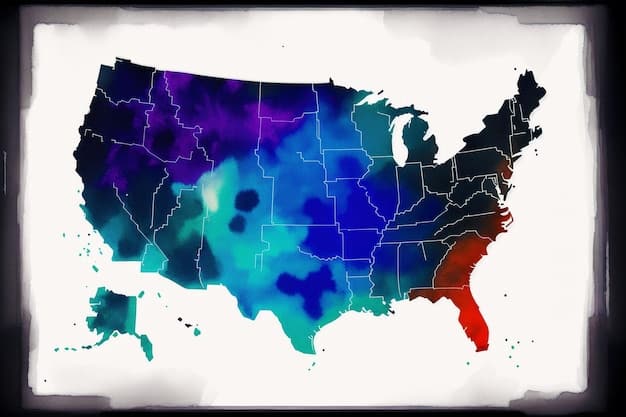Apple Podcasts: New Analytics & Actionable Data for US Podcasters

The new Apple Podcasts Analytics Dashboard offers US podcasters unprecedented access to detailed audience engagement data, providing actionable insights into listener behavior for content optimization, monetization strategies, and growth. This innovative tool represents a significant leap forward in understanding podcast consumption patterns and refining shows for a targeted audience.
Podcast News: Apple Podcasts’ New Analytics Dashboard – What Actionable Data Can US Podcasters Expect? The landscape of podcasting is continuously evolving, and staying ahead means understanding your audience more deeply than ever before. For US podcasters, the recent rollout of Apple Podcasts’ new analytics dashboard marks a pivotal moment, promising a suite of enhanced data insights that could transform how shows are produced, promoted, and monetized.
understanding the new apple podcasts analytics dashboard
The updated Apple Podcasts Analytics Dashboard represents a significant shift in the data available to creators. Historically, podcast analytics have been a fragmented and often opaque field. While basic download numbers provided a broad strokes view, they rarely offered the granular detail needed for true strategic planning. This new dashboard aims to rectify that, providing a more comprehensive and accessible suite of metrics tailored for the modern podcaster.
For US podcasters, understanding the nuances of this new system is paramount. It’s not just about seeing more numbers; it’s about interpreting what those numbers mean in the context of audience behavior and content performance. Apple, being a dominant platform in podcast consumption, holds a unique position to offer insights that are often unavailable elsewhere, given its direct relationship with millions of listeners.
Enhanced Engagement Metrics
One of the most anticipated features of the new dashboard is its focus on engagement. Moving beyond simple downloads, podcasters can now dive into how listeners interact with individual episodes. This includes data points that reveal exactly when listeners tune in, when they drop off, and which segments they might be skipping or replaying. Such granular information is invaluable for refining content and ensuring it resonates with the target audience.
- Listen Through Rate: This metric indicates the percentage of an episode that listeners consume, providing a direct measure of content stickiness.
- Average Consumption: Tracks the average amount of time listeners spend with each episode, allowing for better pacing and segment planning.
- Skipped Segments: Identifies sections of an episode that listeners frequently skip, highlighting areas that might need re-evaluation or elimination.
- Replayed Segments: Pinpoints parts of an episode that listeners revisit, suggesting moments of particular interest or value.
These engagement metrics move beyond vanity metrics, offering tangible insights into content effectiveness. Knowing where listeners drop off can inform editing decisions, while identifying popular segments can guide future topic selection and even help in structuring ad placement for maximum impact.
The true power lies in the ability to correlate these engagement data points with specific content within an episode. For instance, if a podcaster notices a significant drop-off immediately after an intro, it might signal that the intro is too long or not engaging enough. Conversely, if a particular guest segment is consistently replayed, it suggests that the guest or topic resonated deeply with the audience, prompting future collaborations or deeper dives.
demographics and geographic insights for us audiences
Targeting content effectively requires a deep understanding of who is listening and where they are located. The new Apple Podcasts Analytics Dashboard is designed to provide richer demographic and geographic insights, a critical asset for US podcasters looking to tailor their shows and monetize strategically. While privacy considerations mean direct personal identification is off-limits, the aggregated data offers powerful trends.
Understanding the location of your audience is particularly crucial for US podcasters. Different regions within the United States often have distinct cultural nuances, interests, and even temporal listening habits. For a show aiming to appeal to a specific regional demographic, knowing where the majority of listeners reside can inform content choices, guest invitations, and even local advertising partnerships.
Audience Location Data
The dashboard is expected to provide detailed mapping of listener locations, allowing podcasters to see which cities, states, and even specific geographic areas within the US are tuning in. This information can be incredibly useful for localized content strategies or for pitching to location-specific advertisers.
- State-by-State Breakdown: Visualize listener density across all US states.
- Major Metropolitan Areas: Identify top listening cities, crucial for urban-focused content.
- Regional Hotspots: Pinpoint areas with high engagement, which can indicate niche interest groups.
Beyond broad geographical data, the dashboard can help creators understand how their content performs in different US regions. A podcast about local politics in Texas, for example, would naturally expect a high listenership within that state. However, if the data shows a surprising number of listeners in, say, California, it might indicate a broader appeal or a specific sub-topic that resonates beyond the initial target, opening new avenues for growth and syndicated content.

The true strategic value emerges when combining location data with content performance. Imagine a financial podcast noticing higher engagement from listeners in specific US states known for certain industries. This could prompt them to create content specifically addressing financial trends or news relevant to those industries in those regions. This level of insight allows for highly targeted content creation, moving beyond generic topics to address specific needs and interests of regional audiences.
For monetization, location data is a golden ticket. Advertisers often seek to reach specific geographical markets. A podcaster who can demonstrate a strong, engaged listenership in New York, Los Angeles, or Austin can command higher rates or attract local businesses looking to reach those precise audiences. This direct data empowers podcasters in their sponsorship negotiations, providing verifiable proof of audience reach and engagement in key markets.
content optimization through listener behavior analysis
Content is king, but informed content is strategic. The new Apple Podcasts Analytics Dashboard provides tools that allow US podcasters to move beyond gut feelings and optimize their shows based on concrete listener behavior data. This means understanding not just who is listening, but how they are listening and what keeps them engaged. The goal is to refine existing content and shape future episodes for maximum impact and audience retention.
The ability to drill down into episode-level performance is a game-changer. Podcasters can now see exactly which parts of an episode captivate their audience and which cause listeners to drop off. This “heat map” of listener engagement is invaluable for iterative improvement. It allows for A/B testing of segment formats, intro lengths, and even the pacing of discussions. Imagine testing two different types of intros for subsequent episodes and seeing which one yields a higher listen-through rate. This direct feedback loop is what makes content optimization truly data-driven.
Pinpointing Engagement Peaks and Drops
The dashboard is expected to visually represent listener engagement throughout an episode’s timeline. This visual feedback can immediately highlight areas for improvement or replication.
- Interaction Graph: A visual representation showing listener retention as an episode progresses.
- Hot Spots: Specific timestamps where listenership spikes or remains consistently high.
- Churn Points: Moments where a significant percentage of listeners drop off.
Analyzing churn points is particularly critical. If a large number of listeners consistently abandon an episode at the five-minute mark, it forces a critical examination of what happens at that point. Is it an unengaging transition? A confusing explanation? An overly long advertisement? Identifying and addressing these issues can significantly improve overall listener retention and satisfaction. This iterative process of analysis, adjustment, and re-evaluation is fundamental to long-term show growth.
Furthermore, understanding engagement peaks allows podcasters to double down on what works. If a particular segment featuring listener Q&A consistently sees high engagement and replays, it signals an opportunity to incorporate more Q&A segments or even dedicate entire episodes to listener interaction. This feedback loop ensures that content remains relevant and continues to meet the evolving expectations of the audience, fostering a strong and loyal listener base.
For US podcasters, this level of detailed feedback can inform not only content but also format. If shorter, punchier episodes consistently outperform longer ones, it might suggest a need to adjust episode length. If interview segments are consistently more engaging than solo monologues, it could prompt a shift in show structure. The data provides a roadmap for evolving the show in a way that resonates most powerfully with its audience, ensuring continued relevance and growth in a competitive market.
monetization strategies informed by analytics
For many US podcasters, monetization is a key objective, and the new Apple Podcasts Analytics Dashboard provides unprecedented data to inform and optimize these strategies. Moving beyond guesswork, podcasters can now align their content, audience, and advertising efforts with data-backed insights, maximizing revenue potential.
The core principle here is to demonstrate value to potential advertisers. Advertisers are increasingly sophisticated in their demands for measurable results. By providing detailed metrics on listen-through rates, audience demographics, and geographic distribution, podcasters can present a compelling case for their show’s advertising potential. This shift from anecdotal evidence to concrete data empowers podcasters in negotiations, allowing them to justify higher ad rates and attract more relevant sponsors.
Optimizing Ad Placement and Frequency
One of the most immediate applications of the new engagement data is the optimization of ad placement. Knowing when listeners are most engaged, or conversely, when they tend to drop off, can help podcasters strategically place ads to minimize disruption and maximize their impact. Ads placed during highly engaged segments are more likely to be heard and acted upon.
- Pre-Roll Placement: Understanding early listener retention can inform the length and content of pre-roll ads.
- Mid-Roll Effectiveness: Pinpointing natural break points or low-engagement segments for mid-roll ads to avoid listener churn.
- Post-Roll Reach: Gauging how many listeners stay until the very end to determine the viability of post-roll ads.
Beyond placement, the data can inform frequency. If analytics show that too many ads lead to significant listener drop-off, podcasters can adjust their ad load to strike a balance between monetization and listener retention. This delicate balance is crucial for long-term growth and sustainable revenue. The dashboard provides the necessary feedback loop to fine-tune this aspect of the content strategy.
Furthermore, knowing the specific demographics and geographic locations of engaged listeners allows for more targeted ad sales. A podcast focused on healthy living might attract advertisers for organic food products. If the analytics show a strong listenership in specific health-conscious regions of the US, the podcaster can approach local health food stores or fitness centers in those areas, offering highly localized and relevant advertising opportunities. This micro-targeting is incredibly attractive to advertisers seeking efficient spend.
The ability to showcase detailed audience engagement metrics also opens doors to new monetization avenues beyond traditional advertising. This might include attracting premium sponsors who value deep engagement, exploring listener-supported models with a clear value proposition, or even developing merchandise that appeals directly to the identified listener interests. With precise data, podcasters can be more creative and strategic in building a sustainable and profitable show.
integrating analytics into the podcast production workflow
The true power of the new Apple Podcasts Analytics Dashboard isn’t just in seeing data; it’s in actively integrating those insights into the daily and weekly podcast production workflow. For US podcasters, this means transforming raw numbers into actionable steps that drive improvement and growth. It’s about creating a feedback loop where listener behavior directly informs content creation, editing, and promotion.
Integrating analytics requires a systematic approach. It’s not enough to glance at the dashboard once a month. Podcasters should schedule regular reviews of their data, perhaps weekly or bi-weekly, to identify trends and anomalies. This consistent monitoring allows for timely adjustments and prevents small issues from snowballing into significant problems. The goal is to make data analysis a natural and indispensable part of the creative process.
Establishing a Data Review Routine
Creating a structured approach to reviewing analytics ensures that insights are consistently captured and acted upon. This might involve dedicated time slots for data analysis or specific team members assigned to monitor performance indicators.
- Weekly Deep Dive: Review engagement metrics for newly released episodes and compare them to historical performance.
- Monthly Trend Analysis: Identify overarching trends in listenership, demographics, and content preferences.
- Post-Mortem for Underperforming Episodes: Analyze episodes with high churn rates to understand the contributing factors.
Beyond just looking at the numbers, the key is to ask “why?” Why did a particular episode perform exceptionally well in terms of listen-through rate? Why did another see a significant drop-off? These questions lead to hypotheses that can then be tested in subsequent episodes. For example, if a guest interview episode saw high engagement, the hypothesis might be that interviews resonate strongly with the audience, prompting more such content.

Integrating analytics also means fostering a data-aware mindset among the entire podcast production team. Editors can use churn point data to tighten up transitions or remove unnecessary preamble. Hosts can adapt their delivery or segment structure based on engagement peaks. Marketing teams can use demographic and geographic data to target promotional efforts more effectively. When everyone understands the data, the entire production process becomes more cohesive and audience-centric.
For small, independent US podcasters, integrating analytics might seem daunting. However, even dedicating 30 minutes a week to review key metrics can yield significant benefits. Start with the most actionable data points, like listen-through rates and geographical distribution, and gradually expand the analysis as comfort and understanding grow. The investment of time in data analysis will be repaid in improved content, increased audience retention, and ultimately, greater show success.
future implications and competitive advantage for us podcasters
The introduction of Apple Podcasts’ new analytics dashboard isn’t just a new feature; it’s a strategic move that has significant future implications for US podcasters, particularly in terms of gaining a competitive advantage. In an increasingly crowded podcasting landscape, access to superior data can be the differentiating factor between a show that merely exists and one that thrives and grows.
This enhanced data empowers podcasters to be more agile and responsive to market demands. The ability to quickly identify what resonates with an audience and what doesn’t allows for rapid adaptation of content strategy. In a fast-paced media environment, this responsiveness can mean the difference between staying relevant and falling behind. Podcasters who embrace this data-driven approach will be better positioned to attract and retain listeners.
Building a Competitive Edge through Data
For US podcasters, leveraging these analytics can translate into direct competitive advantages not available to those who rely solely on intuition or basic download numbers. Data-informed decisions lead to more optimized content and growth.
- Audience Segmentation: Identify and target specific subsets of your US audience with tailored content or advertising.
- Niche Identification: Discover underserved topics or formats that resonate strongly with your audience, allowing for niche domination.
- Platform Optimization: Fine-tune content delivery for Apple Podcasts’ specific audience behavior, potentially impacting featured placements.
The competitive landscape within podcasting in the US is fierce. Thousands of new shows launch every month, vying for listener attention. In this environment, having detailed analytics is no longer a luxury but a necessity. It enables podcasters to make precise, evidence-based decisions about their content, ensuring that every minute of production time is maximized for audience impact.
Furthermore, access to Apple’s unique first-party data provides insights that third-party analytics simply cannot. Since Apple directly controls a massive portion of the podcast listening experience, their data offers a direct window into how their users are interacting with content. This proprietary data gives US podcasters a unique advantage, allowing them to decode listener behavior patterns that might be invisible elsewhere.
Finally, the future of podcast monetization and growth will increasingly rely on sophisticated data. As advertisers become more discerning, they will prioritize shows that can demonstrate clear ROI through robust analytics. US podcasters who master the use of Apple’s new dashboard will be at the forefront of this evolution, not only producing better content but also building more sustainable and profitable businesses as a result.
| Key Metric | Brief Description |
|---|---|
| 📈 Listen Through Rate | Measures how much of an episode listeners consume, indicating engagement. |
| 🗺️ Geographic Data | Shows listener location (state, city) for targeted content and monetization. |
| 👂 Engagement Peaks/Drops | Identifies specific episode segments where listeners engage or drop off. |
| 💰 Monetization Insights | Data informing ad placement optimization and higher ad rates. |
frequently asked questions about apple podcasts analytics
▼
The new Apple Podcasts Analytics Dashboard is an enhanced set of tools within Apple Podcasts Connect, providing detailed metrics on how listeners interact with podcasts. It moves beyond basic downloads to offer granular data on engagement, listen-through rates, audience geography, and more, empowering US podcasters to optimize their content and monetization strategies effectively.
▼
For US podcasters, the dashboard offers specific geographic insights, allowing them to see listener distribution across states and cities. This enables highly localized content creation, targeted ad sales for regional businesses, and a deeper understanding of American audience preferences, crucial for competitive advantage in the US market.
▼
Podcasters can expect actionable data like specific timestamps where listeners drop off or replay content, helping to refine episode structure and identify engaging segments. They’ll also see listen-through rates for individual episodes, demographic insights to tailor content, and geographic data to inform localized marketing and sponsorship efforts.
▼
Absolutely. By understanding listener engagement patterns, podcasters can strategically place ads within episodes to maximize impact and minimize disruption. Detailed demographic and geographic data also allows podcasters to demonstrate their audience’s value to potential advertisers, justifying higher ad rates and attracting more relevant sponsorships.
▼
The new dashboard is an evolution and enhancement of the analytics previously available, aiming to provide more depth and actionable insights. While it builds upon existing functionalities, it substantially expands the scope of data presented, offering a more comprehensive view of podcast performance and listener behavior for creators.
conclusion
The advent of Apple Podcasts’ new analytics dashboard represents a transformative moment for US podcasters. No longer reliant on rudimentary download counts, creators now possess a sophisticated toolkit filled with actionable data. From understanding precise listener engagement points to refining content based on geographic and demographic insights, this dashboard offers an unparalleled opportunity to craft more compelling shows, optimize monetization strategies, and secure a significant competitive advantage in the dynamic podcasting landscape. Embrace these insights, and your podcast journey will be guided by data, leading to more informed decisions and sustainable growth.





